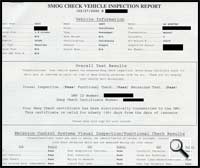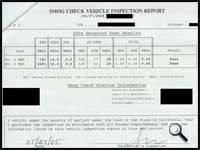Eliminator
GT2X equipped Project B6 goes in for emissions testing!!
Just how “stealthy” is the eliminator
series? We decided to put it to the test!
Anyone who is a performance enthusiast and lives
in California knows that modifying the engine bay
components for more power means having to “un-modify”
for the bi-annual emissions test in order to receive
the registration sticker for the next year.
State law states that you cannot modify anything
in the engine bay with an aftermarket component unless
that component has gone through the state board evaluation
process and has received prior approval for use. During
the “visual” stage of the inspection,
the typical emissions technician can dismiss and FAIL
the entire emissions test on a vehicle if he sees
anything that is not of original equipment. If an
after market component is found, an accompanying approval
sticker from the state board must be in plain view.
The second stage of the inspection requires that the
technician do an approximately 20 point inspection
of all key emissions related components (e.g. vacuum
lines, sensors, catalysts, exhaust, CEL light activity,
error codes, etc.) to ensure proper functionality
of the engine’s on-board diagnostic system.
Anything out of place here will also fail the entire
inspection. Finally, the most important of all, the
emissions output of the vehicle is measured. The limits
have been preset for each vehicle in a database and
when that vehicle type is inspected, the inspection
computer verifies the collected data against the data
in the database. Anything above the limits will also
result in immediate failure of the entire test.
Having confidence in the way we have designed our
eliminator turbo system with the turbo placed in the
original location and with all the emissions related
devices retained in this kit, we volunteered our project
car for a random emissions test just like if it was
time to renew the registration!
We randomly selected a test station at a random location
and under the microscope it went!
The technician cautiously proceeds by sifting through
the engine bay, looking at every component with a
flashlight to see if anything “stands out”.
Nothing there: project B6 (with 300+ hidden HP) appears
100% stock. The car had passed the white glove test
and the “visual” part was over. With the
car running, a connector was hooked up to the diagnostic
port. It has the ability to monitor the functionality
of every sensor on the vehicle from the evaporative
emissions hose to the catalyst temperature to the
pre and post 02 sensors to the amount of airflow at
the MAF. Everything checked out with no CEL and no
DTC’s. It passes the second stage of the emissions
test. Next came the tailpipe “sniffer”
test which measures the actual levels of emissions
output at different operating rpms and load conditions.
The suspense builds as the technician subjects the
car to the various test conditions under the order
of the instructions on the screen of the testing system.
Then, the long awaited printout comes out of the laser
printer next to the station. PASS
PASS PASS. Our Eliminator equipped project
car had performed, but this time it performed like
“stock” and looked like “stock”
when it needed to be stock. Refer to the attached
emission test results for actual emissions output
measured.


Note:
The point of this exercise was to determine how well
the Eliminator series turbo kit responds to today’s
emissions testing requirements. We realize now that
the discreteness of the kit can allow it to “fly
under the radar”, but we are by no means suggesting
that the kits are currently California smog legal.
They are not! These kits, just like most other turbo
kits on the market are currently only available for
purchase to be used off- road only! We are currently
going through the CARB approval process for these
kits and the products are pending the approval of
the state board for mass use. Until the point the
approval has been granted, these kits are not legal
for public highway use in California.

